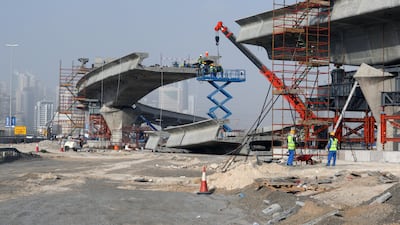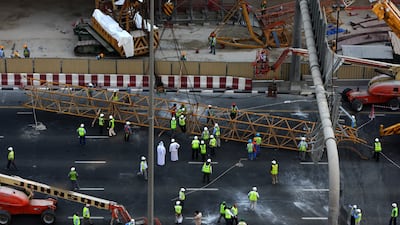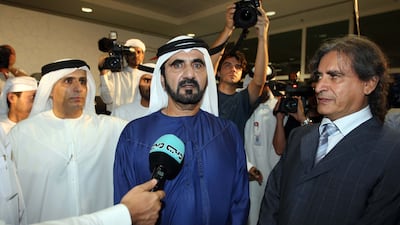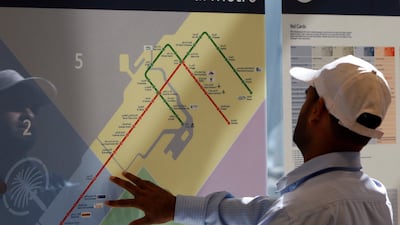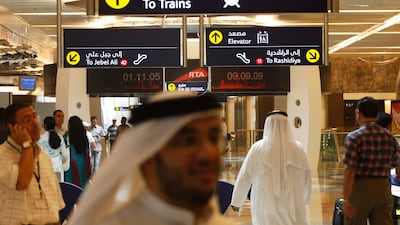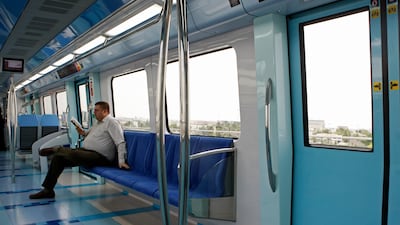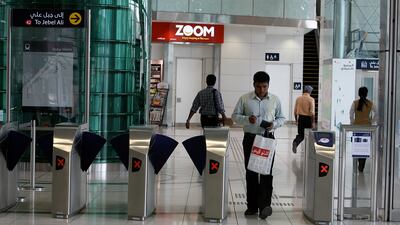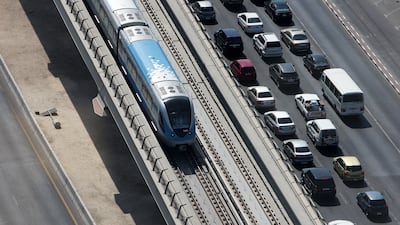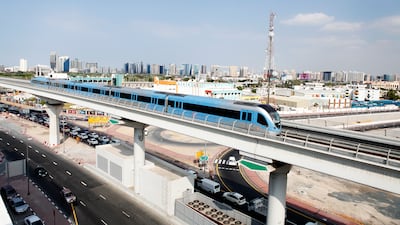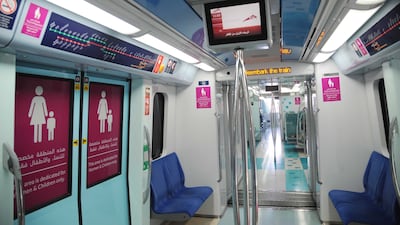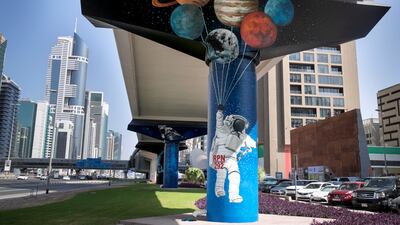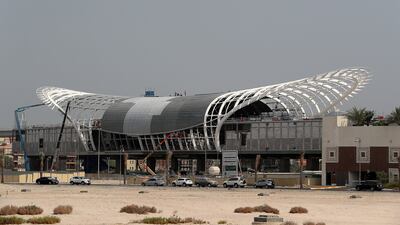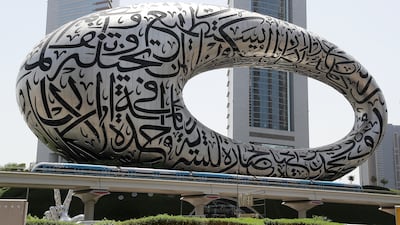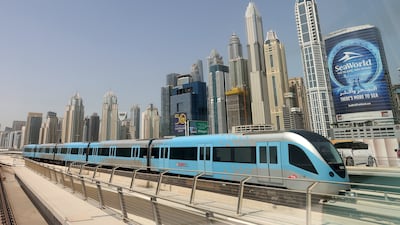It was all change for Dubai's growing public transport network when the first metro on the Arabian Peninsula was launched 15 years ago today.
Ten stations on one line opened on the symbolic date of September 9, 2009 – 09/09/09 – for dignitaries and guests before the public got a chance to sample Dubai Metro in the following days.
Residents had faced years of construction and some international reports questioned if the Metro would be a success in a city of about two million, dominated by cars. It also came amid a global recession.
A report for The National on the day conveyed the anticipation in the city in the hours and minutes before it launched. “Dubai was infused with mounting excitement … as the authorities geared up for tonight's launch, tying up countless loose ends,” it said. “And the tracks were busy with the already familiar blue trains making test runs.”
Public transport in Dubai in 2006 was limited to a few public buses, taxis and abras crossing Dubai Creek. Mattar Al Tayer, then executive director of the Roads and Transport Authority, said it accounted for only 6 per cent of the total movement of residents in the emirate.
Mr Al Tayer, now the director general, also said on Dubai TV that congestion cost the Dubai economy $1.4bn a year because of lost time and accidents.
“I would say it changed my life,” said Mita Srinivasan, a Dubai resident since 1989. “We were all fed up of driving.” Ms Srinivasan, who eagerly used the Metro in those first few days, had watched on in the years before as the stations and lines emerged in the city, promising a future that didn’t mean long drives in an increasingly congested city.
“People had already begun to talk about climate and transport and pooling,” she said. “There was lots of excitement, right from the beginning.”

The story of a dream
The dream of a metro, however, started decades earlier. On a visit to London in 1959, Sheikh Rashid bin Saeed, Ruler of Dubai at the time, was captured at the controls of a London Underground train.
Sheikh Rashid first travelled as a passenger from Piccadilly station to Earl’s Court. “Then the train thundered on to Hammersmith – but this time driven by the Ruler himself, who was quick to grasp the technique and thoroughly enjoyed this novel experience,” a note in the Arabian Gulf Digital Archive reads.
His son, Sheikh Mohammed bin Rashid, Vice President and Ruler of Dubai, was just 10 when he accompanied Sheikh Rashid on this visit. “Dubai Metro was once a dream,” Sheikh Mohammed said later.
“I was 10 years old when I visited London in 1959 with my father who insisted to see a train’s cockpit. Fifty years later, Dubai Metro came true in 2009. Nothing is impossible if you can dream it.”











Metro’s early successes
Construction of the Metro started in 2006. The Red Line opened in 2009. Just two years later, in 2011, Sheikh Mohammed opened the second. The Green Line served the historic and heavily populated areas around Dubai Creek.
According to Mr Al Tayer, the Metro had 39 million riders in 2010, increasing to 69 million the following year. “With the launch of the Green Line of Dubai Metro in Sept 2011, metro riders rocketed to 109 million riders in 2012,” he told the state news agency Wam in 2019.
Just two years on from that first journey the Metro was beginning to have an effect. A city seen as car-centric had now given residents another option beyond the car and congested roads.
Monica Menendez, professor of civil and urban engineering at New York University Abu Dhabi, said cities here were planned for cars but authorities understand it is not sustainable now for everyone to have a car.
“Let’s assume the money is there to pay for transportation projects,” she said. “If it is a car-centric city, it would probably mean that most people drive. All those people who are driving are getting stuck in traffic in Dubai. You give them the option, they would say build more lanes.
"There’s no demand for public transportation ... because there’s not a good public transportation system. You need to build it first to create a demand after.”

How trains change perceptions of a city
Questions about its viability soon wore off as people flocked to the trains and the Metro quickly became part of the city’s identity. This is what Dubai’s leaders aimed for when launching the Roads and Transport Authority in 2005 and the Metro soon after.
It was not just about shifting people from point A to point B, though, but proving more options and trying to get residents and visitors to consider the environment and choose public transport as a preferred mode of transport rather than a last resort.
“If everyone drives in the cars, you don't have this mixing of people, mixing of cultures and people speaking different languages on the same train,” said Prof Menendez. “You don't get that experience.”
For tourists this makes the city more accessible and affordable and avoids having to deal with car rentals or taxis. And it changes the perception of the city for tourists and residents too.
“Everyone looks different, everyone speaks differently and everyone is dressed differently. This is very cosmopolitan," she said. "It's like I'm acting as a local. It changes how you perceive the city as a tourist but also as a resident.”
Rail systems regionally
Dubai Metro has saved about 1 billion car journeys since its launch in 2009, Mr Al Tayer said in 2022. Mr Al Tayer, who is also chairman of the board of executive directors of the authority, said the Metro had reduced carbon dioxide emissions by 2.6 million tonnes, with the cumulative financial benefits amounting to Dh115 billion.
Dr Alexandra Gomes, research fellow at the London School of Economics, who has analysed cities in the Gulf, said public transportation systems such as the Metro are vital for alleviating traffic congestion, reducing commuting times, lowering road traffic accidents and cutting local pollution.
“This is especially critical in the Gulf region where, for example, accidents and pollution levels rank among the highest globally, with significant environmental and human consequences,” she said. “Nevertheless, many Gulf cities remain heavily car-dependent and continue to focus their investments primarily on improving their road networks.
"Well-designed rail infrastructure can help promote higher urban density, mixed-use development, and increase walkability – factors that contribute to healthier, more liveable, and sustainable cities. A shift that is particularly urgent in the context of a growing climate crisis.”
Good business sense
Mr Al Tayer in 2015 said Dubai Metro has triggered a rise in the value of properties situated within a 1.5km radius of Metro stations on both the Red and Green Lines by amounts ranging from 13 per cent to 41 per cent. The Metro brings trains, increases footfall and leads to further development in areas where there are stations.
This is a trend already seen in cities such as Tokyo and Hong Kong, where stations are not simply where you get the train but where you eat, shop and socialise. The city can develop along these lines. “When you create a station, you bring a lot of ... movement around the station,” said Prof Menendez.
“In most cities, the real estate prices for everything: residential, retail and offices go up when you're close to this area,” she said. “A mall [operator] might come and say I'm going to build in this area because I know I can get customers from far away just through the Metro.”

The future of connectivity
The Red Line was extended to Dubai South for Expo2020 Dubai and is already serving an expanding community there that will eventually incorporate Dubai’s new airport. Much of Dubai remains reliant on buses though, and in June Dubai set out plans to more than double its number of Metro and tram stations by 2040 in a boost to aspirations for what is known as the 20-minute city, as Dubai's population is now around 3.7m.
It followed the announcement in February that work on Dubai’s third Metro line, the Blue Line, would begin this year. The Dh18 billion ($4.9 billion) project will include 14 stations and add 30km to the network, more than half of it underground. It will connect the expanding new areas of Dubai such as Dubai Creek Harbour and connect to the existing network.
Further connections are expected to Etihad Rail, the UAE-wide network expected to open for passengers by 2030. This integration, when completed, is expected to transform not just Dubai but the UAE and the Gulf.
"If you take the Metro away, imagine,” said Prof Menendez, “it will be problematic in Dubai, right? Which means by now the Metro is important. My hope and assumption is that it will become more and more important.”
15 years of growth
More than two billion passengers have used the Dubai Metro since its launch on September 9, 2009, Dubai Media Office said last year. The Red Line has transported 1.34 billion commuters while the Green Line served more than 673 million.
The contribution of public transport and shared mobility hit 20.9 per cent by the end of 2023, the RTA said. It is hoped this will increase to 25 per cent by 2030, with Dubai Metro leading the charge.
In the first half of 2024, the number of passengers reached 361 million, an average of 1.98 million per day and a 6 per cent growth compared to the first half of 2023. Built at a cost of billions of dollars, Mr Al Tayer said Dubai Metro broke even in 2016, seven years after launching, and said projections indicate that by 2030, every dirham spent will yield benefits worth Dh4.
“When it launched, we were not sure,” said Ms Srinivasan. "Now it is part of the furniture.”
